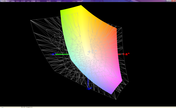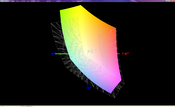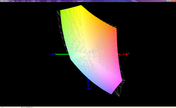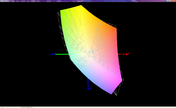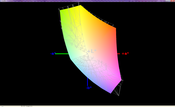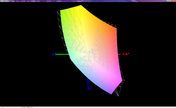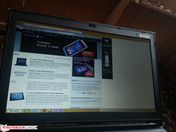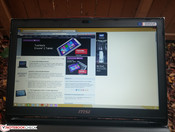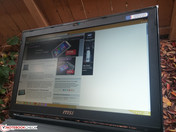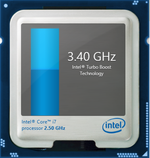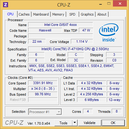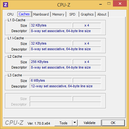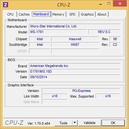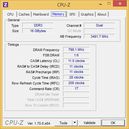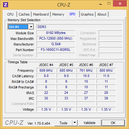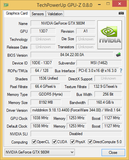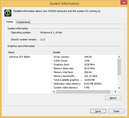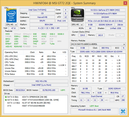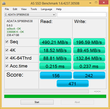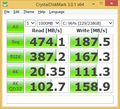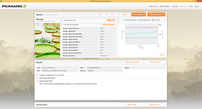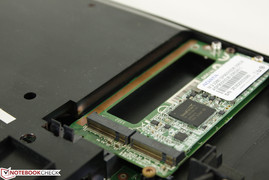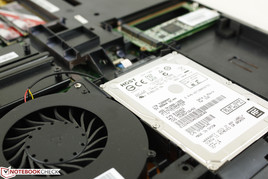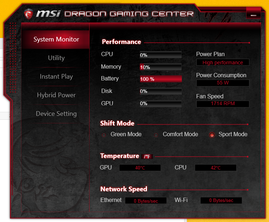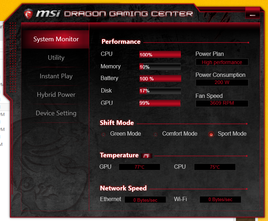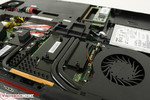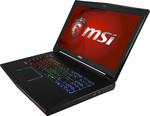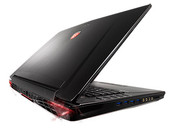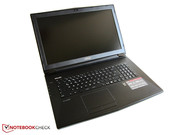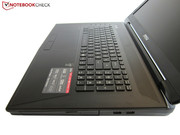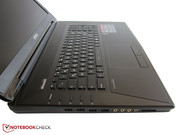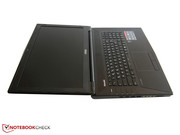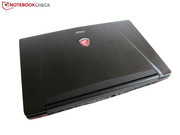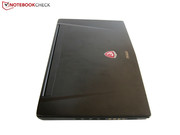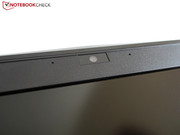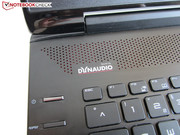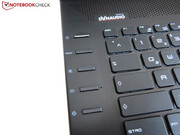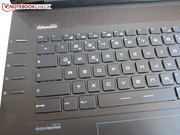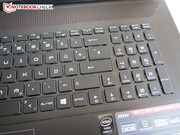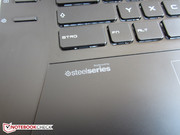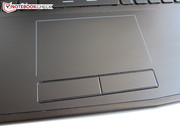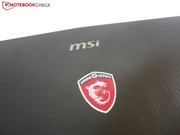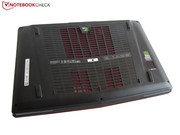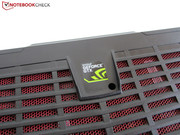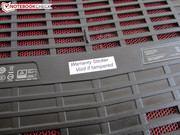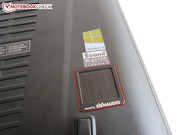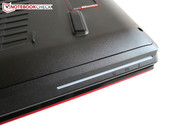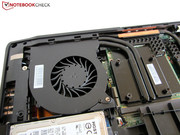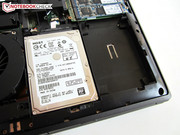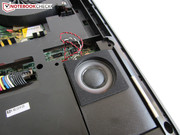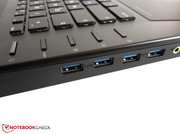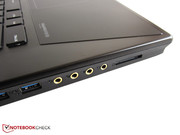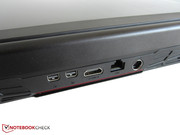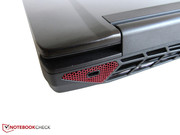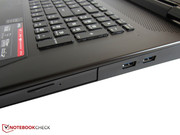iBuyPower GT72 Dominator Notebook Review Update
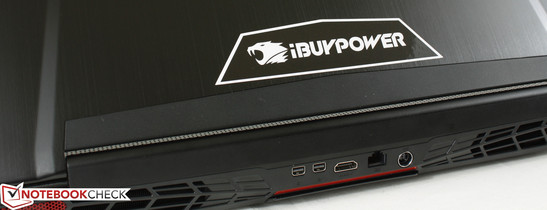
When MSI boasted their updated G Series lineup at CES 2014, we were fairly disappointed to see the outdated and years old designs essentially untouched on the 15-inch and 17-inch GT models. The newly named Dominator model was the same old GT70 we've known since early 2012. Thus, when the completely redesigned GT72 hit the market just earlier this year, we genuinely had our "Hell, it's about time" moment the second we heard the news.
Fortunately, the refreshed model did not disappoint. We've taken very close looks at the GT72: first with the GTX 880M back in September and then again with the GTX 980M in late October. As such, more detailed analyses and hardware features of the notebook can be found in these previous reviews. Today's GT72 is from reseller iBuyPower, a brand that gamers should be well aware of, especially in the eSports scene. This particular model is a part of their Optiboost family, which means end-users can still benefit from factory warranties despite the extensive customization options that the reseller offers.
As we have already discussed the general hardware, we will jumping straight to performance and stress testing with the iBuyPower GT72. Is GPU power reduced on batteries? What throttling issues should users be wary of? Does the turbo fan feature really make a difference? And how does performance compare against the likes of Alienware and Asus ROG models?
Display
The GT72 can only be equipped with a 1080p matte display; Other higher resolution options are currently reserved for the thin MSI Stealth models. Nonetheless, display quality is clean and our measurements below confirm our results from our previous test models. Most notably, the display does not suffer from specific color or noise issues like we witnessed on the Asus G750JW last year. The Chi Mei N173HGE-E11 panel is also common on a number of 17.3-inch Acer models including the Aspire V3 and Aspire E5.
| |||||||||||||||||||||||||
Brightness Distribution: 84 %
Center on Battery: 263.8 cd/m²
Contrast: 1178:1 (Black: 0.224 cd/m²)
ΔE ColorChecker Calman: 11.85 | ∀{0.5-29.43 Ø4.78}
ΔE Greyscale Calman: 11.75 | ∀{0.09-98 Ø5}
56.31% AdobeRGB 1998 (Argyll 1.6.3 3D)
64% AdobeRGB 1998 (Argyll 3D)
87.3% sRGB (Argyll 3D)
64.2% Display P3 (Argyll 3D)
Gamma: 2.22
CCT: 14746 K
| Ibuypower GT72 Dominator GeForce GTX 980M, 4710HQ, ADATA Premier Pro SP900NS38 256 GB | Asus G750JZ-T4023H GeForce GTX 880M, 4700HQ, 2x Sandisk X110 SD6SP1M-128G RAID 0 | Aorus X7 Pro GeForce GTX 970M SLI, 4870HQ, 2x Lite-On LMT-256L9M (RAID 0) | MSI GT70 2PE-890US GeForce GTX 880M, 4800MQ, HGST Travelstar 7K1000 HTS721010A9E630 | One K56-4N Radeon R9 M290X, 4700MQ, Samsung SSD 840 EVO 500GB | |
|---|---|---|---|---|---|
| Screen | |||||
| Brightness middle (cd/m²) | 263.8 | 275 4% | 318 21% | 324 23% | 229 -13% |
| Brightness (cd/m²) | 255 | 258 1% | 283 11% | 302 18% | 211 -17% |
| Brightness Distribution (%) | 84 | 80 -5% | 82 -2% | 83 -1% | 79 -6% |
| Black Level * (cd/m²) | 0.224 | 0.49 -119% | 0.54 -141% | 0.35 -56% | 0.38 -70% |
| Contrast (:1) | 1178 | 561 -52% | 589 -50% | 926 -21% | 603 -49% |
| Colorchecker dE 2000 * | 11.85 | 3.34 72% | 3.79 68% | 10.55 11% | 8.58 28% |
| Greyscale dE 2000 * | 11.75 | 2.2 81% | 2.35 80% | 11.01 6% | 10 15% |
| Gamma | 2.22 99% | 2.5 88% | 2.37 93% | 2.62 84% | 2.29 96% |
| CCT | 14746 44% | 6654 98% | 6775 96% | 14184 46% | 11104 59% |
| Color Space (Percent of AdobeRGB 1998) (%) | 56.31 | 58 3% | 58 3% | 54 -4% | 58 3% |
* ... smaller is better
Color space reproduction is a little over 76 percent of the sRGB standard or just 56 percent of AdobeRGB. While certainly superior to budget panels where color coverage is typically 60 percent of sRGB, this is standard amongst gaming notebooks of this class. This may be a $2000 notebook, but professional graphics artists should be looking into workstations like the HP ZBook series or specialized panels as found on certain Eurocom models for extreme color accuracy. The current TN panel on the GT72 is sufficient for gaming needs.
Further color analyses with a X-Rite spectrophotometer reveal inaccurate colors and grayscale out of the box. Correlated color temperature is overly cool and Cyan in particular is inaccurate across all saturation levels. Calibration improves the display dramatically: the RGB curve is flattened and the average dE2000 color deviation reduces to just 5.19 from over 11 units. Though not essential for daily use or gaming, a display calibration is recommended on the GT72.
Outdoor usability is difficult and not recommended. Aside from the obvious size and weight disadvantages, the backlight is insufficient for overcoming ambient light on such a large 17.3-inch monitor. The matte panel is mainly a perk in indoor situations to avoid reflections that a glossy display would otherwise have.
Unlike Ultrabooks and other superthins, a large percentage of gaming notebooks remain tied to TN displays for their superior response times. Of course, this is at the cost of viewing angle stability and accurate colors. Onscreen images remain relatively stable if viewing from the sides, but colors quickly degrade and invert when viewing from more obtuse angles. Nonetheless, it's still quite easy to share the display with others nearby due to the large display and 180 degree hinges.
Performance
Our test unit houses a 2.5 GHz Intel Core i7-4710HQ. iBuyPower also offers configurations with the more high-end i7-4980HQ, which is about 300 to 500 MHz faster than the i7-4710HQ in raw clock speeds. Otherwise, both these quad-core Haswell options have equal cache sizes and use integrated Intel HD 4600 GPUs. Running on the Power Saver profile will limit CPU speeds to just 800 MHz. Note that switching between the integrated and Nvidia discrete graphics requires restarting the notebook. The equipped i7-4710HQ is more than enough for gaming, so gamers should not feel compelled to splurge $400 more for a faster CPU.
RAM is supplied by 2x SODIMM G.Skill modules for a total of 16 GB and with 2x more SODIMM slots to spare on the bottom of the notebook. Opening up the panel will also reveal the two system fans, subwoofer, M.2 SSDs, 2.5-inch HDD and both the CPU and GPU.
Processor
The CPU in our GT72 performs similarly to other i7-4710HQ processors in our database with no outliers or other abnormal results. Certain notebooks equipped with the same CPU tend to score much lower than our GT72 due to inferior Turbo Boost. The IdeaPad Y50, for example, completes wPrime 1024M in about 320 seconds compared to just 254 seconds on the GT72.
Compared to desktop processors, our Multi-core CineBench R15 score of 631 points is just 1 percent and 5 percent shy from the popular i7-2600K and AMD FX-8350, respectively, while drawing just a fraction of the power. Compared to the previous mobile generation, this Haswell core is most similar to the Ivy Bridge i7-3820QM while operating at a slower 200 MHz core clock.
For more benchmarks and technical information on the Core i7-4710HQ, see our dedicated CPU page here.
| Cinebench R15 - CPU Multi 64Bit (sort by value) | |
| Ibuypower GT72 Dominator | |
| Asus G750JZ-T4023H | |
| Aorus X7 Pro | |
| MSI GT70 2PE-890US | |
| One K56-4N | |
| Cinebench R11.5 - CPU Multi 64Bit (sort by value) | |
| Ibuypower GT72 Dominator | |
| Asus G750JZ-T4023H | |
| Alienware 18 | |
| Aorus X7 Pro | |
| MSI GT70 2PE-890US | |
| One K56-4N | |
System Performance
According to PCMark 7, system performance is on par with other high-end gaming notebooks that sport dedicated SSDs including the Aorus X7, MSI GS70, and the Eurocom X3. PCMark 8 benchmark results are some of the highest in our database as well and are in fact higher than our Gigabyte P35X V3, which sports the same GTX 980M GPU. Navigation is almost instantaneous with no latency or frame skips. The day-to-day feel of Windows is not all that different from an Ultrabook, but with a much more powerful GPU.
| PCMark 7 Score | 6088 points | |
| PCMark 8 Home Score Accelerated v2 | 4897 points | |
| PCMark 8 Creative Score Accelerated v2 | 5427 points | |
| PCMark 8 Work Score Accelerated v2 | 5011 points | |
Help | ||
Storage Devices
The GT72 forgoes mSATA slots in favor of 4x M.2 slots with RAID 0 capabilities. Our particular model is equipped with just a single 256 GB M.2 ADATA drive, but iBuyPower will configure for single drives as small as 128 GB or quadruple drives as large as 512 GB each. Competing gaming notebooks typically offer 2x RAID 0 or even 3x RAID 0 in the case of Aorus, so 4x RAID 0 can be considered an even smaller niche for the portable gaming crowd. These M.2 drives are more common amongst Ultrabooks and it's a bit of a surprise to see them in such a configuration for a large gaming notebook such as this.
For additional storage, the model is equipped with a standard 2.5-inch SATA III slot. We recommend a 9.5 mm HDD of at least 500 GB for installing games and other media.
Sequential transfer rates according to Crystal Disk Mark are far below that of our previous GT72 due to having only one SSD. However, the benchmark results in general are as expected from a single SATA III-class SSD. Our growing benchmark comparison table of SSDs and HDDs can be seen here.
Gaming Performance
The GTX 980M is the most powerful single GPU solution in the mobile market as of this writing. In fact, the overall 3DMark 11 score of 10793 points is comparable to the AMD 8790M Crossfire found on the One K73-3S barebones notebook. We've already had a couple of 980M GPUs tested and benchmarked, so definitely check out our dedicated GPU page for more benchmarks and technical information on the 980M.
In short, this is a monster of a card that can play most any title as of 2014 on 1080p60. For more intensive titles like Last Light or Sleeping Dogs, however, don't expect a perfectly locked 60 FPS experience as frames will still fluctuate down to the low to mid 50s depending on the situation. Nonetheless, titles can be played on their maximum settings without technical or driver issues as of ForceWare 344.00.
| low | med. | high | ultra | |
|---|---|---|---|---|
| StarCraft 2 (2010) | 126 | 86 | ||
| Sleeping Dogs (2012) | 152 | 58 | ||
| Guild Wars 2 (2012) | 71 | 60 | ||
| Tomb Raider (2013) | 245 | 103 | ||
| BioShock Infinite (2013) | 177 | 91 | ||
| Metro: Last Light (2013) | 105 | 65 | ||
| Company of Heroes 2 (2013) | 63 | 38 | ||
| Thief (2014) | 82 | 60 | ||
| GRID: Autosport (2014) | 142 | 103 | ||
| Ryse: Son of Rome (2014) | 100 | 86 | ||
| Call of Duty: Advanced Warfare (2014) | 92 | 61 |
| Tomb Raider - 1920x1080 Ultra Preset AA:FX AF:16x (sort by value) | |
| Ibuypower GT72 Dominator | |
| Alienware 18 | |
| Aorus X7 Pro | |
| MSI GS60 - 2PEWi716SR21 | |
| One K56-4N | |
| Guild Wars 2 - 1920x1080 All Maximum / On AA:FX (sort by value) | |
| Ibuypower GT72 Dominator | |
| Alienware 18 | |
| Aorus X7 Pro | |
| Metro: Last Light - 1920x1080 Very High (DX11) AF:16x (sort by value) | |
| Ibuypower GT72 Dominator | |
| Alienware 18 | |
| Aorus X7 Pro | |
| MSI GS60 - 2PEWi716SR21 | |
| One K56-4N | |
| BioShock Infinite - 1920x1080 Ultra Preset, DX11 (DDOF) (sort by value) | |
| Ibuypower GT72 Dominator | |
| Asus G750JZ-T4023H | |
| Alienware 18 | |
| Aorus X7 Pro | |
| MSI GS60 - 2PEWi716SR21 | |
| One K56-4N | |
| Company of Heroes 2 - 1920x1080 Maximum / Higher / High AA:High (sort by value) | |
| Ibuypower GT72 Dominator | |
| Asus G750JZ-T4023H | |
| Alienware 18 | |
| Sleeping Dogs - 1920x1080 Extreme Preset AA:Extreme (sort by value) | |
| Ibuypower GT72 Dominator | |
| Alienware 18 | |
Compared to competing devices like the Asus G750 (GTX 880M), One K56-4N (Radeon M290X), and Aorus X7 Pro (GTX 970M SLI), the GT72 holds its own extremely well. Raw GPU performance according to 3DMark is handily above the 880M, 870M, and especially the M290X, while systems with SLI solutions still edge out Nvidia's single GPU crown. Even the older 780M SLI is just a few percent points higher and the same can be observed during in-game benchmarks. However, note that a number of titles favor the 980M over the 780M SLI, including Tomb Raider and the much more intensive Last Light.
| 3DMark 06 Standard Score | 28852 points | |
| 3DMark 11 Performance | 10793 points | |
| 3DMark Ice Storm Standard Score | 127448 points | |
| 3DMark Cloud Gate Standard Score | 21953 points | |
| 3DMark Fire Strike Score | 8227 points | |
| 3DMark Fire Strike Extreme Score | 4242 points | |
Help | ||
| 3DMark - 1920x1080 Fire Strike Graphics (sort by value) | |
| Ibuypower GT72 Dominator | |
| Asus G750JZ-T4023H | |
| Alienware 18 | |
| Aorus X7 Pro | |
| One K56-4N | |
| MSI GS60 - 2PEWi716SR21 | |
| 3DMark 11 - 1280x720 Performance GPU (sort by value) | |
| Ibuypower GT72 Dominator | |
| Asus G750JZ-T4023H | |
| Alienware 18 | |
| Aorus X7 Pro | |
| One K56-4N | |
| MSI GS60 - 2PEWi716SR21 | |
Stress Test
We use the stress test benchmarks Prime95 and FurMark to identify any throttling or stability issues with CPU-Z, GPU-Z, and HWiNFO monitoring tools active. With only Prime95 running, the CPU will run at its maximum 3.3 GHz Turbo Boost until core temperatures reach about 87 degrees C, which takes less than half a minute. At this point, the CPU drops to a more steady 2.9 to 3.0 GHz range and core temperatures remain stable in the 75 degrees C zone. Thus, the processor is able to maintain a Turbo Boost of about 500 to 600 MHz above its 2.4 GHz base speed when under full CPU stress. If the turbo fan is enabled, core temperatures drop a few degrees closer to 70 degrees C, but performance remains unchanged.
With just FurMark active, the 980M GPU operates at a steady 834.9 to 847.6 MHz core clock with a 1252.8 MHz memory according to GPU-Z. This is about 200 MHz below its base speed of 1034 MHz, which suggests that the GPU is unable to sustain higher speeds nor can it benefit appreciably from GPU Boost when at maximum stress. Like the Intel CPU, the Nvidia GPU will operate at its fastest for the first minute or so before leveling off. GPU temperature plateaus at 80 degrees C. Note that setting the system Shift Mode to Green or Comfort will limit the GPU core to the 468.9 to 810 MHz range, which further reduces performance.
When under both Prime95 and FurMark stress, the CPU and GPU remain in their respective 2.9 to 3.0 GHz and 834.9 to 847.6 MHz ranges. Power consumption under this extreme state is slightly above 200 Watts or at least 4x the demand when idling. After a full hour of stress, we experienced no throttling or stability issues on the GT72.
Running on batteries will reduce CPU and GPU performance. A 3DMark 11 run on batteries returns Physics and graphics scores of 7460 and 6184 points, respectively, compared to 8171 and 12142 points on mains. This is due to the wildly fluctuating cores as the CPU and GPU will occasionally drop to 800 MHz and 162 MHz, respectively, when under consistently high stress.
(November 24, 2014 Update): To better represent more real-world gaming conditions, we run Unigine Heaven 4.0 at our native 1080p resolution for a full hour with active monitoring tools to observe for any CPU or GPU throttling.
Results differ from our findings above as processing loads are not consistently 100 percent of CPU or GPU time. Thus, both the CPU and GPU are able to maintain higher Boosts of 3.3 to 3.4 GHz and 1113.8 to 1126.4 MHz, respectively. There are moments when the CPU will drop to its base 2.5 GHz speed, but these are very brief before quickly returning to the near-maximum Turbo Boost rate. The GPU operates with a very steady GPU Boost as well and never dips. Core temperatures are much cooler this time around at 50 to 70 degrees for the CPU and 70 degrees for the GPU. Compared to our more synthetic Prime95 and FurMark tests, the numbers for Unigine Heaven are much more promising.
Emissions
System Noise
MSI have finally moved away from the single system fan setup of the previous G Series generation to a dual-fan setup not unlike those from Asus, Alienware, and Aorus. The two fans in the GT72 are identical in size (as opposed to the asymmetrical fans on certain Clevo barebones) to provide a more even cooling solution. The fans will spin at around 1600 RPM when idling or at low power and can increase up to about 2700 to 3000 RPM under stressful conditions.
Fan noise is expected from gaming notebooks and the GT72 is no different. Its idling fan noise of about 35 dB(A) jumps quickly to the 40 dB(A) range when gaming or performing other moderate tasks. This is enough to be distracting when playing games or listening to music without headphones.
The turbo fan feature will lock fan speeds to almost 3700 RPM for a noise level of about 57 dB(A). This is significantly louder than most gaming notebooks out there, including the Alienware 17, and headphones are almost required at this point. The feature is not particularly recommended for small LAN parties as the noise is enough to be distracting to others nearby.
Noise level
| Idle |
| 34.2 / 34.5 / 34.8 dB(A) |
| DVD |
| 37 / dB(A) |
| Load |
| 39.1 / 49.7 dB(A) |
 | ||
30 dB silent 40 dB(A) audible 50 dB(A) loud |
||
min: | ||
Temperature
Surface temperature when idling is flat across both the top and bottom sides of the notebook. This is in contrast to the Alienware 17 or older GT70 model where specific corners can be up to 5 degrees C warmer than the coolest spot.
Under maximum stress for over an hour, hot spots of over 50 degrees C can be measured on the bottom rear of the notebook close to the ventilation grilles. The temperature gradient is quite steep, but this high concentration means that the rest of the notebook is quite cool in comparison. The palm rests and keyboard, for example, experience a much smaller rise in temperature. Users will be able to play games comfortably without needing to worry about sweaty fingers on the WASD keys. This is also an improvement over the original GT70 as both sides of the keyboard and notebook in general are more even in temperature.
(+) The maximum temperature on the upper side is 35.4 °C / 96 F, compared to the average of 40.4 °C / 105 F, ranging from 21.2 to 68.8 °C for the class Gaming.
(-) The bottom heats up to a maximum of 53.4 °C / 128 F, compared to the average of 43.3 °C / 110 F
(+) In idle usage, the average temperature for the upper side is 25.4 °C / 78 F, compared to the device average of 33.9 °C / 93 F.
(+) The palmrests and touchpad are cooler than skin temperature with a maximum of 25.8 °C / 78.4 F and are therefore cool to the touch.
(+) The average temperature of the palmrest area of similar devices was 28.9 °C / 84 F (+3.1 °C / 5.6 F).
Battery Life
The redesign has made the once easily replaceable 87 Wh battery non-removable. We wouldn't mind if this meant a substantial increase in battery life, but runtimes are still standard for a gaming notebook.
We've imported our numbers from our previous GT72 model and have added a comparison table against other 17.3-inch models. Note that all of our runtime numbers were performed with the dGPU active except for our idling benchmark. Runtimes are not significantly better or worse than the general competition. Our WiFi runtime on the GT72 is noticeably lower, but that is because we performed the same test on other notebooks with the iGPU instead. Users can expect 3 to 4 hours of constant WiFi use (or less with an active dGPU) before needing to recharge.
| Ibuypower GT72 Dominator GeForce GTX 980M, 4710HQ, ADATA Premier Pro SP900NS38 256 GB | Asus G750JZ-T4023H GeForce GTX 880M, 4700HQ, 2x Sandisk X110 SD6SP1M-128G RAID 0 | Alienware 17 (GTX 880M) GeForce GTX 880M, 4700MQ, WDC Scorpio Blue WD10JPVX-75JC3T0 | Aorus X7 Pro GeForce GTX 970M SLI, 4870HQ, 2x Lite-On LMT-256L9M (RAID 0) | MSI GT70 2PE-890US GeForce GTX 880M, 4800MQ, HGST Travelstar 7K1000 HTS721010A9E630 | One K56-4N Radeon R9 M290X, 4700MQ, Samsung SSD 840 EVO 500GB | |
|---|---|---|---|---|---|---|
| Battery runtime | ||||||
| Reader / Idle (h) | 6.6 | 9.6 45% | 7.7 17% | 3 -55% | 6.5 -2% | 4.6 -30% |
| WiFi (h) | 3.1 | 6.3 103% | 5.8 87% | 6.5 110% | 3.5 13% | |
| Load (h) | 1.5 | 1.2 -20% | 1.2 -20% | 1.4 -7% | 1.2 -20% | 1.9 27% |
Verdict
The GT72 is the bump that MSI needed from a design perspective to get themselves back in the gaming ring. It lies somewhere between the the outlandish Alienware models and the more achromatic design of the Asus ROG series while providing more streamlined features than the former and better end-user upgradeability than the latter. Performance is spot on with consistent Turbo Boost and no stability or throttling issues to note. The GTX 980M is also certainly powerful enough for 4K gaming at respectable settings on an external monitor.
Some downsides include the non-removable battery and inaccurate display colors out-of-the-box. Brightness is lower than on the older GT70, but still bright enough for indoor use. Performance on batteries is underwhelming and it's also a bit pricey at $2179 for the GTX 980M and $1839 for the 970M as of this writing. The Aorus X7 retails in the same price range, but offers SLI solutions in an arguably sleeker and thinner package. Fortunately, iBuyPower throws in a two-year warranty as standard instead of the usual one-year warranty with replacement parts and support as needed. There aren't too many notebooks equipped with GTX 980M GPUs just yet, but the GT72 has us excited to see what tricks other manufacturers may have up their sleeves.




